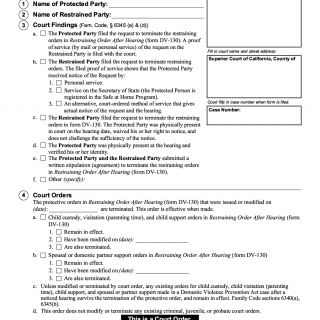DV-400. Findings and Order to Terminate Restraining Order After Hearing
DV-400, Findings and Order to Terminate Restraining Order After Hearing, is a legal form used in California to request the termination of a restraining order after a hearing. The main purpose of this form is to formally terminate a restraining order that was previously issued by the court.
The form consists of several parts, including a section for the court's findings, a section for the court's order terminating the restraining order, and a section for the judge's signature.
Some of the important fields that need to be carefully considered when completing the form include the names of the parties involved, the date of the original restraining order, and the reason for the termination.
The parties involved in completing the form include the person who requested the termination of the restraining order, the person who was subject to the restraining order, and the judge who presided over the hearing.
When filling out the form, the person requesting the termination of the restraining order will need to provide detailed information about why the restraining order should be terminated. Additionally, they may need to attach additional documents, such as evidence of changed circumstances or proof of completion of a required program.
Application examples of DV-400 include situations where the parties involved in the restraining order have reconciled, or where the circumstances that led to the restraining order are no longer present. One strength of the form is that it provides a formal process for terminating a restraining order, which can help provide closure and peace of mind for the parties involved. However, one weakness is that it can be a complex legal process, especially for those who are not familiar with the legal system.
Related forms include DV-110, which is used to request a restraining order, and DV-130, which is used to request a modification of a restraining order. An alternative form is FL-340, which is used in family law cases to request the termination of a restraining order.
To fill and submit the form, the person requesting the termination of the restraining order will need to download the form from the California Courts website, complete it, and file it with the court. The form will then be reviewed by a judge, who will make a decision on whether to terminate the restraining order. The form is stored in the court's database and can be accessed by the parties involved in the case.

